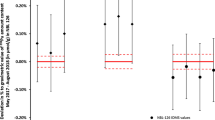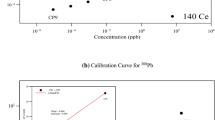Abstract
The accurate determination of boron (B) at trace and ultratrace concentrations is an important step toward establishing the role of B in biological functions. However, low-level B concentrations are difficult to determine accurately, especially for many botanical and biological matrices. A round-robin study was conducted to assess analytical agreement for low-level B determinations. Ten experienced research groups from analytical laboratories extending across Europe, Asia, and the US participated in this study. These groups represent a crosssection of academic, commercial, and government facilities. The researchers employed both ion-coupled plasma and neutron techniques in the study. Results from this round-robin study indicate good agreement between participating laboratories at the mg/kg level, but at the lowest levels, μg/kg, only three laboratories participated, and agreement was poor. By encouraging discussion among scientists over these data, the secondary goal of this round-robin study is to stimulate continued improvement in analytical procedures and techniques for accurate low-level B determinations. Furthermore, it is intended to encourage the development of a variety of low-level (low mg/kg and (μg/kg) B certified reference samples in biological and botanical matrices. The results from the round-robin analyses were compiled and are summarized in this article.
Similar content being viewed by others
References
D. J. Fort, T. L. Propst, E. L. Stover, P. L. Strong, and F. J. Murray, Adverse reproductive and development effects inXenopus from insufficient B,Biol. Trace Element Res. (this vol.).
R. I. Rowe, C. Bouzan, S. Nabili, and C. D. Eckert, Essentiality of boron for vertebrate embryonic development in trout and zebrafish,Biol. Trace Element Res. (this vol.).
F. H. Nielsen, The saga of boron in food: from a banished food preservative to a beneficial nutrient for humans,Current Topics Plant Biochem. Physiol. 10, 274–286 (1991).
F. H. Nielsen, Biochemical and physiologic consequences of boron deprivation in humans,Environ. Health Perspect. 102, 59–63 (1994).
C. D. Hunt, The biochemical effects of physiologic amounts of dietary boron in animal nutrition models,Environ. Health Perspect. 102, 35–43 (1994).
C. J. Lovatt, and W. M. Dugger, Boron, inBiochemistry Essential Elements, vol.3, Frjeden, E., ed., Plenum, New York, pp. 389–421 (1984).
A. Lamberty, L. V. Nevel, J. R. Moody, and P. D. Bièvre, The IRMM—International Measurement Evaluation Programme, IMEP-3: International Comparison of Trace Element Measurements in Synthetic and Natural Water,Accreditation and Quality Assurance 1, 71–82 (1996).
L. Van Nevel, P. Taylor, U. Örnemark, and P. D. Bièvre, The International Measurement Evaluation Programme (IMEP): IMEP-6 “Trace Elements in Water” Report to Participants, Institute for Reference Materials and Measurements, GEEL (1996).
Survey of Reference Materials, IAEA, Vienna (1995).
K. Usuda, K. Kono, K. Iguchi, K. Nishiura, K. Miyata, M. Shimahara, et al., Hemodialysis effect on serum boron level in the patients with long term hemodialysis,Sci. Total Environ. 191, 283–290 (1996).
H. R. Imbus, J. Cholak, L. H. Miller, and T. Sterling, Boron, cadmium, chromium, and nickel in blood and urine,Arch. Env. Health 6, 286 (1963).
F. R. Abou-Shakra, J. M. Havercroft, and N. I. Ward, Lithium and boron in biological tissues and fluids,Trace Elemental Med. 6, 142 (1989).
W. B. Clarke, C. E. Webber, M. Koekebakker, and R. D. Barr, Lithium and boron in human blood,J Lab. Clin. Med. 109, 155–158 (1987).
D. L. Anderson, W C. Lindstrom, and T. R. Lindstrom, Concentrations and intakes of H, B, S, K. Na, C, and NaCl in Foods,J. Food Comp. Anal. 7, 59 (1994).
C. J. Rainey, L. A. Nyquist, R. E. Christensen, P. L. Strong, B. C. Culver, and J. R. Coughlin, Daily boron intake from the American diet,J. Am. Dietetic Assoc., in press (1998).
R. D. Barr, W. B. Clarke, R. M. Clarke, J. Venturelli, G. R. Norman, and R. G. Downing, Regulation of lithium and boron levels in normal human blood: environmental and genetic considerations,J. Lab. Clin. Med. 121, 614–619 (1993).
R. D. Barr, S. A. Barton, and W. J. Schull, boron levels in man: preliminary evidence of genetic regulation and some implications for human biology,Med. Hypotheses 46, 286–289 (1996).
F. G. Smith, D. R. Wiederin, R. S. Houk, C. B. Egan, and R. E. Serfass, Measurement of boron concentration and isotope ratios in biological samples by inductively coupled plasma mass spectrometry with direct injection nebulization,Analy. Chimica Act. 248, 229–234 (1991).
S. A. Wise, M. M. Schantz, B. J. Koster, R. Demiralp, E. A. Mackey, R. R. Greenberg, et al., Development of frozen blubber and liver reference materials for the measurement of organic and inorganic contaminants,Fresenius’ J. Anal. Chem. 345, 270–277 (1993).
W. B. Clarke, M. Koekebakker, R. D. Barr, R. G. Downing, and R. E Fleming, Analysis of ultratrace lithium and boron by neutron activation analysis and massspectrometric measurement of3He and4He,Appl. Radiat. Isotopes 38, 735–743 (1987).
D. L. Anderson, W. C. Cunningham, and E. A. Mackey, Determination of boron in food and biological reference materials by neutron capture prompt-γ activation,Fresenius’ J. Anal. Chem. 338, 554–558 (1990).
G. V. Iyengar, W. B. Clarke, and R. G. Downing, Determination of boron and lithium in diverse biological matrices using neutron activation-mass spectrometry (NA-MS),Fresenius’ J. Anal. Chem. 338, 562–566 (1990).
C. D. Hunt, Dietary boron Deficiency and Supplementation, inTrace Elements in Laboratory Rats, R. R. Watson, ed., CRC, Boca Raton, FL, pp. 229–253 (1996).
Author information
Authors and Affiliations
Rights and permissions
About this article
Cite this article
Downing, R.G., Strong, P.L. A round-robin determination of boron in botanical and biological samples. Biol Trace Elem Res 66, 23–37 (1998). https://doi.org/10.1007/BF02783123
Published:
Issue Date:
DOI: https://doi.org/10.1007/BF02783123




